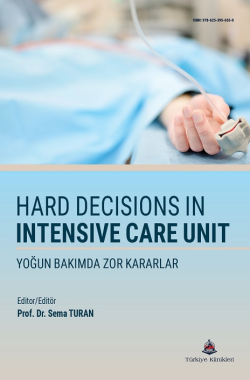EXTRACORPOREAL LIVER SUPPORT SYSTEMS
Ebru Ayöztürk
Ankara Bilkent City Hospital, Department of Intensive Care, Ankara, Türkiye
Ayöztürk E. Extracorporeal Liver Support Systems. In: Turan S, editor. Hard Decisions in Intensive Care Unit. 1st ed. Ankara: Türkiye Klinikleri; 2025. p.151-157.
ABSTRACT
As it is known, in acute liver failure, there is inadequacy in the synthesis of plasma proteins, especial- ly albumin, coagulation and fibrinolytic factors, detoxification of drugs and toxins, the eliminations of ammonia and bilirubins, which are the major functions of the liver. Extracorporeal Liver Sup- port (ECLS) is a therapy that implements these primary functions of the liver to decrease mortality in acute chronic liver failure (AoCLF), to allow time for regeneration of hepatocytes in acute liver failure or to prepare a patient to liver transplantation. This chapter discusses the available status of extracorporeal cellular (bioartificial) liver assist devices including extracorporeal liver assist device (ELAD), HepatAssist, extracorporeal liver support system (MELS), and the bioartificial liver support and non cellular extracorporeal liver assist devices that includes molecular adsorbent recirculating system (MARS), Prometheus—Fractionated plasma separation and adsorption system (FSPA), single pass albumin dialysis (SPAD), and selective plasma filtration treatment (SEPET). An overview as well as current based on the results of studies these therapies will be presented in detail.
Keywords: Acute liver failure; Extracorporeal liver support; Albümin dialysis; MARS; Prometheus
Kaynak Göster
Referanslar
- Perez Ruiz de Garibay A, Kortgen A, Leonhardt J, Zipprich A, Bauer M. Critical care hepatology: definitions, incidence, prognosis and role of liver failure in critically ill patients. Crit Care. 2022;26(1):289. [Crossref] [PubMed] [PMC]
- Wendon J, Cordoba J, Dhawan A, Larsen FS, Manns M,Samuel D, Kenneth J Simpson et al. EASL Clinical Practical Guidelines on the management of acute (fulminant) liver failure. J Hepatol. 2017;66:1047-81. [Crossref] [PubMed]
- Stange J. Extracorporeal liver support. Organogenesis. 2011 Jan-Mar;7(1):64-73. [Crossref] [PubMed] [PMC]
- Wiesmann T, Hoenl D, Wulf H, Irqsusi M. Extracorporeal liver support: trending epidemiology and mortality - a nationwide database analysis 2007-2015. BMC Gastroenterol. 2019;19(1):160. [Crossref] [PubMed] [PMC]
- Nguyen A, Mirza A, Javed N, Hanif H, Ryu M, Mirza RT, et al. Extracorporeal Liver Support: An Updated Review of Mechanisms and Current Literature. J Community Hosp Intern Med Perspect. 2022;12(4):43-48. [Crossref] [PubMed] [PMC]
- Tsipotis E, Shuja A, Jaber BL. Albumin Dialysis for Liver Failure: A Systematic Review. Adv Chronic Kidney Dis. 2015;22(5):382-390. [Crossref] [PubMed]
- Gadour E, Kaballo MA, Shrwani K, Hassan Z, Kotb A, Aljuraysan A, Miuţescu B, Sherwani N, Mahallawi W. Safety and efficacy of Single-Pass Albumin Dialysis (SPAD), Prometheus, and Molecular Adsorbent Recycling System (MARS) liver haemodialysis vs. Standard Medical Therapy (SMT): meta-analysis and systematic review. Prz Gastroenterol. 2024;19(2):101-111. [Crossref] [PubMed] [PMC]
- Saliba F, Camus C, Durand F, et al. Albumin dialysis with a noncell artificial liver support device in patients with acute liver failure: a randomized, controlled trial. Ann Intern Med. 2013;159(8):522-531. [Crossref] [PubMed]
- Tandon R, Frogi S. Artificial liver support systems. Journal of Gastroenterology and Hepatology. 2021;36:1139-137. [Link]
- Riva I, Marino A, Valetti TM, Marchesi G, Fabretti F. Extracorporeal liver support techniques: a comparison. J Artif Organs. 2024;27(3):261-268. [Crossref] [PubMed] [PMC]
- Kribben A, Gerken G, Haag S, et al. Effects of fractionated plasma separation and adsorption on survival in patients with acute-on-chronic liver failure. Gastroenterology. 2012;142(4):782-789.e3. [Crossref] [PubMed]
- Oppert M, Rademacher S, Petrasch K, Jörres A. Extracorporeal liver support therapy with Prometheus in patients with liver failure in the intensive care unit. Ther Apher Dial. 2009;13(5):426-430. [Crossref] [PubMed]
- Grodzicki M, Kotulski M, Leonowicz D, Zieniewicz K, Krawczyk M. Results of treatment of acute liver failure patients with use of the prometheus FPSA system. Transplant Proc. 2009;41(8):3079-3081. [Crossref] [PubMed]
- Saliba F, Bañares R, Larsen FS, et al. Artificial liver support in patients with liver failure: a modified DELPHI consensus of international experts. Intensive Care Med. 2022;48(10):1352-1367. [Crossref] [PubMed]
- La Manna G, Donati G. Coupled Plasma Filtration Adsorption: A Multipurpose Extracorporeal Detoxification Therapy. Blood Purif. 2018;46(3):228-238. [Crossref] [PubMed]
- Ho DW, Fan ST, To J, et al. Selective plasma filtration for treatment of fulminant hepatic failure induced by D-galactosamine in a pig model. Gut. 2002;50(6):869-876. [Crossref] [PubMed] [PMC]
- Huber W, Henschel B, Schmid R, Al-Chalabi A. First clinical experience in 14 patients treated with ADVOS: a study on feasibility, safety and efficacy of a new type of albumin dialysis. BMC Gastroenterol. 2017;17(1):32. [Crossref] [PubMed] [PMC]
- Kaps L, Schleicher EM, Medina Montano C, et al. Influence of Advanced Organ Support (ADVOS) on Cytokine Levels in Patients with Acute-on-Chronic Liver Failure (ACLF). J Clin Med. 2022;11(10):2782 [Crossref] [PubMed] [PMC]
- Demetriou AA, Brown RS Jr, Busuttil RW, et al. Prospective, randomized, multicenter, controlled trial of a bioartificial liver in treating acute liver failure. Ann Surg. 2004;239(5):660-670. [Crossref] [PubMed] [PMC]
- Thompson J, Jones N, Al-Khafaji A, et al. Extracorporeal cellular therapy (ELAD) in severe alcoholic hepatitis: A multinational, prospective, controlled, randomized trial. Liver Transpl. 2018;24(3):380-393. [PMC]

